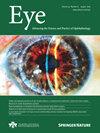Establishing normal interocular symmetry range for macular optical coherence tomography parameters in healthy children
IF 2.8
3区 医学
Q1 OPHTHALMOLOGY
引用次数: 0
Abstract
The study aimed to evaluate the interocular symmetry of macular sublayer thickness among healthy children aged 6-12 years. The Shiraz Pediatric Eye Study included 500 randomly selected children who underwent SD-OCT of the macula and optical biometry using the IOLMaster-500. Exclusion criteria involved ocular abnormalities or axial lengths outside the 21.5–26.5 mm range. Software recorded total retinal thickness and sublayer thickness within each ETDRS subfield. The study included 862 eyes from 431 healthy children, with 254 girls (59%). The anticipated variation in total retinal thickness between eyes was below 13 µm in the fovea and under 7 µm in the inner or outer ring for 95% of the population. For nerve fiber layer and inner plexiform layer, the expected variation ranged from 2 to 4 µm, and for the ganglion-cell layer, it ranged from 2.5 to 5 µm. Intraclass correlation coefficient (ICC) rankings for retinal topography were highest in the outer ring, followed by the inner ring and fovea. The highest ICC for individual layers was found in overall retinal thickness, followed by inner retinal layers, outer-nuclear layer, inner plexiform layer, and inner nuclear layer. The study establishes a reliable reference range for interocular variances in macular sublayers, aiding clinical decision-making. The outer ring (3–6 mm) is most dependable for analysing most sublayers, while the inner ring is most suitable for examining the ganglion-cell layer.

建立健康儿童黄斑光学相干断层扫描参数的正常眼间对称范围。
目的:评价6 ~ 12岁健康儿童黄斑下层厚度的眼间对称性。方法:设拉子儿童眼科研究纳入了500名随机选择的儿童,他们使用IOLMaster-500进行了黄斑SD-OCT和光学生物测定。排除标准包括眼部异常或眼轴长度超出21.5-26.5 mm范围。软件记录了每个ETDRS子视场的视网膜总厚度和亚层厚度。结果:该研究包括431名健康儿童的862只眼睛,其中女孩254只(59%)。在95%的人群中,视网膜总厚度的预期变化在中央窝小于13µm,内环或外环小于7µm。神经纤维层和内丛状层的预期变化范围为2 ~ 4µm,神经节细胞层的预期变化范围为2.5 ~ 5µm。视网膜地形图的类内相关系数(ICC)排名最高的是外环,其次是内环和中央凹。各层ICC最高的是视网膜整体厚度,其次是视网膜内层、外核层、内丛状层和内核层。结论:本研究建立了黄斑亚层眼间差异的可靠参考范围,有助于临床决策。外圈(3-6毫米)是最可靠的分析大多数亚层,而内环是最适合检查神经节细胞层。
本文章由计算机程序翻译,如有差异,请以英文原文为准。
求助全文
约1分钟内获得全文
求助全文
来源期刊

Eye
医学-眼科学
CiteScore
6.40
自引率
5.10%
发文量
481
审稿时长
3-6 weeks
期刊介绍:
Eye seeks to provide the international practising ophthalmologist with high quality articles, of academic rigour, on the latest global clinical and laboratory based research. Its core aim is to advance the science and practice of ophthalmology with the latest clinical- and scientific-based research. Whilst principally aimed at the practising clinician, the journal contains material of interest to a wider readership including optometrists, orthoptists, other health care professionals and research workers in all aspects of the field of visual science worldwide. Eye is the official journal of The Royal College of Ophthalmologists.
Eye encourages the submission of original articles covering all aspects of ophthalmology including: external eye disease; oculo-plastic surgery; orbital and lacrimal disease; ocular surface and corneal disorders; paediatric ophthalmology and strabismus; glaucoma; medical and surgical retina; neuro-ophthalmology; cataract and refractive surgery; ocular oncology; ophthalmic pathology; ophthalmic genetics.
 求助内容:
求助内容: 应助结果提醒方式:
应助结果提醒方式:


